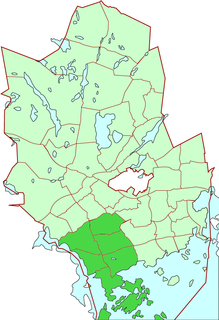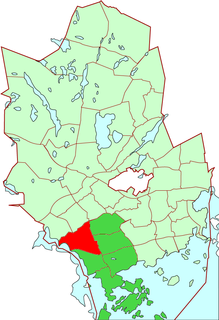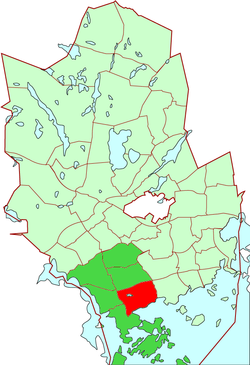
Espoo is the second largest city and municipality in Finland. It is part of the Finnish Capital Region, along with the cities of Helsinki, Vantaa, and Kauniainen, and most of its population lives in the inner urban core of the Helsinki metropolitan area. Espoo shares its eastern border with Helsinki and Vantaa, while enclosing Kauniainen. Other bordering municipalities of Espoo are Nurmijärvi and Vihti in the north, and Kirkkonummi in the west. The city is located on the shore of the Gulf of Finland, in the region of Uusimaa, and has a population of 284,444.

Tapiola is a district of the municipality of Espoo on the south coast of Finland, and is one of the major urban centres of Espoo. It is located in the western part of Greater Helsinki. The name Tapiola is derived from Tapio, who is the forest god of Finnish mythology, especially as expressed in the Kalevala.

Matinkylä (Finnish) or Mattby (Swedish) is one of the major districts of Espoo, a city on the southern coast of Finland. Matinkylä is understood as the area between the Helsinki-Hanko highway and the coast of the Gulf of Finland, between the areas of Haukilahti and Iivisniemi.

Danville Area Community College (DACC) is a community college in Danville, Illinois. It was founded in 1946 as an extension of the University of Illinois; it has grown into an independent college offering courses in 76 areas of study. These include college transfer, occupational degrees and certificates, re-training, skill development, customized training and areas of special interest. As of May 2012, there were 1305 full-time and 3142 part-time students enrolled at the college.

Lauttasaari is an island in Helsinki, about 5 km west of the city centre. Together with some surrounding unpopulated small islands, Lauttasaari is also a district of Helsinki. With 23,226 residents as of 2017, the island is Finland's second largest by population, after Fasta Åland. Its land area is 3.85 km2.

Länsimetro is an extension to the Helsinki Metro system in Finland. The grand opening for the long awaited extension was held on 18 November 2017. Länsimetro extends the system's two lines, M1 and M2, from central Helsinki to the neighbouring city of Espoo. The new stretch continues the lines from the existing Ruoholahti station via the island of Lauttasaari, the Aalto University Otaniemi campus, and Tapiola, the terminus of line M2. M1 continues further west to Matinkylä. Unlike previous extensions to the Helsinki Metro system, Länsimetro runs entirely under ground. The second phase of the construction will continue the line further west to Kivenlahti.

Haukilahti (Finnish) or Gäddvik (Swedish) is a mainly residential district in the city of Espoo, Finland.
Perkkaanpuiston Montessorikoulu was a school unit within a public school offering for the very first time in Finland proper primary school classes using the Montessori method of teaching. The school unit was run by the city of Espoo. Prior to the opening of the school unit, the Montessori method had only been used in preschools.

Sewickley Academy is a private, secular academy located in Sewickley, Pennsylvania. It currently contains 640 students. It is a member of the National Association of Independent Schools. The school's colors are red and black, and the mascot is the Panther.
This is an alphabetical list of the fifty districts of Espoo. Swedish names are given in parentheses.

Mankkaa (Finnish) or Mankans (Swedish) is a suburb of Espoo, located between Tapiola and Kauniainen, with a population of 7,704 (2006), of which 704 speak Swedish as a first language (2005). Most of Mankkaa falls under the postal code 02180, with 02630 being the code of the areas situated near the Helsinki-Turku freeway in the north.

Westend is a district of the city of Espoo, Finland. Known as an affluent area, Westend is the wealthiest postal code area of Finland by mean household income.

Leppävaara is a district of Espoo, a city in Finland. The Rantarata rail line and the Ring Road I, the busiest road in Finland, cross in Leppävaara, thus making it a major traffic hub in the Greater Helsinki region. The Sello Shopping Centre is also located in Leppävaara.

Espoonlahti (Finnish) or Esboviken (Swedish) is one of the five major urban areas of Espoo, a city in Finland. It lies along the south-western coast of Espoo, bounded to the west by the bay of the same name, to the south by the shores of the Gulf of Finland, to the west by the Finnoo (Finnå) valley and to the north by the forests of Espoo central forest area. This total area of about 4,800 hectares is further divided into areas called Soukka, Suvisaaristo, Kaitaa, Nöykkiö, Latokaski and Saunalahti, with one greater center called Espoonlahden keskus. Areas known as Laurinlahti, Ylä-Kivenlahti, Ala-Kivenlahti and Iivisniemi are also part of the Espoonlahti district. Yet another name pertinent to this area is Kanta-Espoonlahti, which includes Espoonlahden keskus, Soukanmäki, Kivenlahti, Laurinlahti and Soukanniemi.

Suur-Espoonlahti (Finnish) or Stor-Esboviken (Swedish) is a south-western main district of Espoo, a city in Finland.

Aalto University is a university located in Espoo, Finland. It was established in 2010 as a merger of three major Finnish universities: the Helsinki University of Technology, the Helsinki School of Economics, and the University of Art and Design Helsinki. The close collaboration between the scientific, business and arts communities is intended to foster multi-disciplinary education and research. The Finnish government, in 2010, set out to create a university that fosters innovation, merging the three institutions into one.
The rantaraitti (Finnish) or strandpromenaden (Swedish) is an urban hiking and cycling route along the coastline of Espoo, Finland, bordering the Gulf of Finland. The approximate total length of the route is 27 km.

Saunalahti (Finnish) or Bastvik (Swedish) is one of the newest apartment building districts in Espoo, Finland, located by the Kummelivuori hill between Kivenlahti and Kurttila, west of the Kauklahdenväylä road, on the coast of the Espoonlahti bay. The bay at Saunalahti is named Bastvikfjärden. The area also contains original detached house residence from old Saunalahti and agriculture. Saunalahti is separated from Kivenlahti by the Länsiväylä highway, continuing to Kirkkonummi as Jorvaksentie.

Konala (Finnish), Kånala (Swedish) is a subdistrict of Helsinki, Finland. Konala has about 4500 inhabitants and about 3000 jobs. Konala is situated in north-western Helsinki, north of Kehä I and Pitäjänmäki, west of Malminkartano and Kannelmäki. It is bordered from the south by Kehä I, east by green zone which separates at the industrial area along Vihdintie and the west at Espoo's border.

Kaitaa (Finnish) or Kaitans (Swedish) is a planned underground station to be built on the western metro extension (Länsimetro) of the Helsinki Metro in Finland. The main entrance of the station is located at the eastern end of the block structure designed for crossing Kaitaantie and Iivisniemenkatu. The West Bank entrance to Hannuskalli, where the preliminary land use plans have outlined further construction. In the March 2018 issue of Metro Matinkylä, Kivenlahti was intended to be handed over to the operating HKL during the year 2023.


















